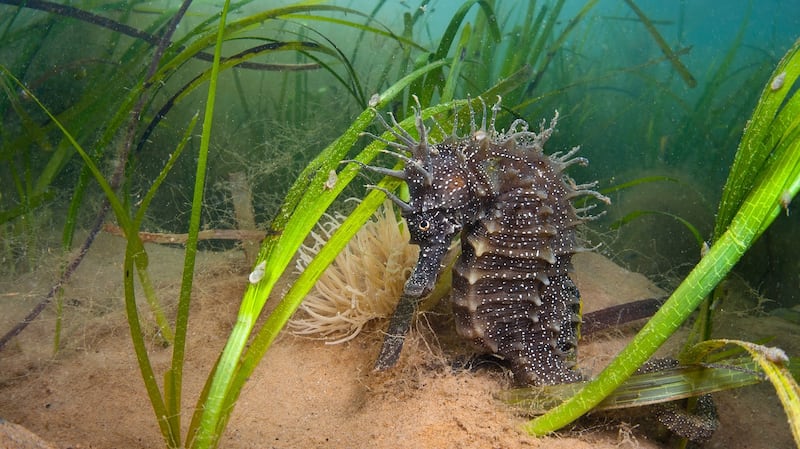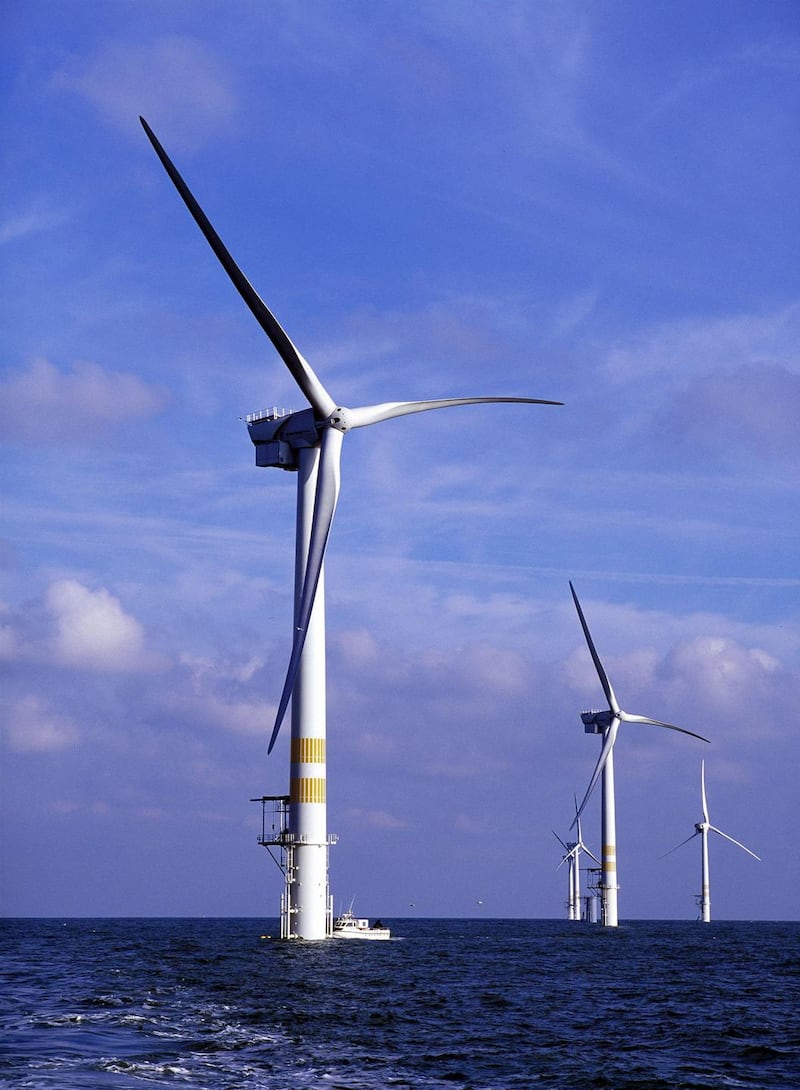The process of scaling up designation of marine protected areas (MPAs) in Ireland to 30 per cent of maritime area over the next decade will begin in earnest this year.
It will be the key mechanism attempting to counter overexploitation, habitat loss and pollution – while also helping to address the threat of climate disruption.
The move is also to protect coastal communities and ensure sustainable tourism, while also scaling up offshore wind energy in line with increased targets aligned with a halving of Ireland's carbon emissions by 2030. It is being overseen by Minister for Housing, Local Government and Heritage Darragh O'Brien and Minister of State for Heritage Malcolm Noonan.
A radical overhaul of both marine planning and conservation measures are imminent following an expert group report on how to complete a coherent network of MPAs. It was chaired by Prof Tasman Crowe of the UCD Earth Institute and involved 20 experts in life and ocean sciences, marine socio-economics, maritime culture, governance and legislation.
The changes are so extensive that two different legal frameworks are to be put in place: one for spatial planning arising from human activities including fishing and renewable energy (notably offshore wind development), the other for determining and designating MPAs to protect nature and biodiversity of species and habitat, according to a recent Department of Housing, Local Government and Heritage briefing.
Later this week, the draft Marine Planning and Development Management Bill and Ireland's first marine spatial planning framework will be published.
There is minimal protection of Ireland’s seas, covering just 10,420sq km. At 2.13 per cent of Ireland’s total maritime area of nearly 488,762sq km, this is among the lowest in the world.
“This is far short of the international targets to which Ireland is committed. Current Irish legislation does not define MPAs and is limited in its ability to enable the conservation of many of Ireland’s threatened or important species, habitats and other marine features of biological or cultural significance,” Prof Crowe confirmed at the briefing.
Coherent
Ireland’s network of protected areas “cannot be considered coherent, representative, connected or resilient or to be meeting Ireland’s international commitments and legal obligations”, his report concludes. “There is no definition of MPA in Irish law... The provisions of the Wildlife Acts, as amended, are limited in terms of their geographic scope, applying only to the foreshore.”
This means currently protection in marine areas beyond 12 nautical miles is limited to measures taken under the EU Birds and Habitats Directives or the Ospar Convention for the protection of the marine environment of the north-east Atlantic. “In effect, habitats and species that are not listed in the EU directives, but which may be locally, nationally or internationally important, cannot currently be afforded the necessary protection.”

The expert group strongly endorses the aim of protecting biodiversity in crisis, creating a sustainable future, and meeting climate change challenges, but implementation will be contentious, it warns, if it is not correctly handled and backed by extensive consultation.
The approach has to be “respectful of the needs of people and communities, as well as to the environment of which they are a part”, it adds.
Prof Crowe confirmed new legislation is urgently needed to designate species and habitats not listed on EU directives, especially beyond 12 nautical miles of the coastline. There are 19 species and 10 habitats threatened or in serious decline. These include basking and angel sharks; two species of seahorse, the European eel, native oysters, coral gardens and seagrass beds which provide a habitat for many species and capture carbon.
While there is concern about “a mismatch in timing”, existing legislation and environmental regulation will apply until MPAs are up and running. “MPAs are not the only game in town,” he underlined.
Under the new marine planning framework, for instance, new wind installations will not be waved through. Vigorous environmental impact assessments will be required, and careful consideration of locations.
MPA locations
The department's principal advisor on the marine environment, Richard Cronin, said for logistical reasons it was already known where wind developments were likely to be located. The new marine spatial plan would set demanding requirements on noise, biodiversity and marine litter that would feed into the decision-making process, to ensure they are located safely in the right places.
This would apply to the construction phase, where noise is the most significant threat, and to the operational phase, when “the sweep of the blades” must be considered. Understanding the impact of each of those reduces the threat and risk, he added.
The expert report does not suggest where MPAs should be located, but summarises relevant thinking about designating these sea areas in an Irish context, and sets out how the existing small number of MPAs in Irish waters could be expanded. The report suggests “a great opportunity exists to radically improve the framework for managing Ireland’s marine environment and to secure its benefits for future generations”.
Societal considerations
The nature and consequences of MPAs are not always well communicated to or appreciated by the public, it underlines. “Some people will be concerned about the impacts of MPAs on their livelihoods and the fairness of distribution of costs and benefits. People’s value systems and sense of place can strongly influence their perception of MPAs as being positive or negative developments.”
It adds: “People need to understand what MPAs are trying to achieve and why management measures are being put in place that may restrict their activities. It is also important to ensure that benefits and costs are distributed as fairly as possible and that the opportunities offered by an expanded network are recognised and grasped.”
If well planned, resourced and managed, an expanded MPA network would make an invaluable contribution to the stewardship of Ireland’s wealth of marine life, culture and heritage, helping to underpin the long-term conservation and sustainable management of thriving marine ecosystems, it concludes.

When the draft report was issued last February, the Irish Wildlife Trust said it was a crucial step towards safeguarding more of Ireland’s diminishing marine life that must be acted on swiftly by the Government.
Coastwatch director Karin Dubsky welcomed its emphasis on public participation and consideration of a range MPA types. "Some of the key messages are so well written and strong that one feels like putting them up as banners around the Convention Centre where our elected representatives now meet," she added.
However, Ms Dubsky noted “the snail’s pace which has characterised Ireland’s marine designation process so far and even slower actual protection of designated areas looks set to continue, which we must address now.” The consultation phase ends at the end of July. Legislation on MPAs is to be published towards the end of the year.
The report comes at a critical time for Ireland, according to Mr Noonan. “Decades of poor planning and under-investment in our marine and coastal areas have resulted in unsustainable outcomes for our marine environment and the coastal communities that depend on it.
“As we enter the UN Decade on Ecosystem Restoration, and progress towards an ambitious post-2020 global framework for biodiversity, the development of a coherent and effective network of MPAs is a strategic priority in helping us to achieve our goals for nature.”
MEP Grace O’Sullivan, the Green Party spokeswoman for marine, said the report would help ensure Ireland complies with the European Commission’s 2030 biodiversity strategy and ensure the ambitions of the UN Agenda 2030’s sustainable development goal 14 – on “life below water” – are reached.
She added: “Ongoing and ambitious work in this area is vital... 70 per cent of the planet is made up of oceans and seas. In Ireland, we’re surrounded by seas full of marine biodiversity. But our seas and their living inhabitants are in danger. We need to protect that environment. We have a responsibility to expand our MPAs and ensure that vital ecosystems can recover and that fish can breed to a sustainable level.”
Protecting this vital resource was about protecting the livelihoods of fishers, communities and other stakeholders too, she noted. “Our seas are being overfished. We must conserve and protect or fish stocks will be further critically depleted and that would be tragic on every level. It makes environmental sense and it makes economic sense.”












